- All eyes on today's US CPI print amid ongoing inflation debate
- Europe outperforms, betting on the reflation trade
- Oil steadies
- Bank of England Governor Andrew Bailey speaks on Thursday.
- On Thursday initial jobless claims in the US will be announced.
- US figures for PPI will be released on Thursday.
- On Friday US retail sales figures are due to be published.
- Futures on the S&P 500 Index were little changed.
- The FTSE 100 Index increased 0.8%.
- The STOXX 600 Index gained 0.6%.
- The MSCI Asia Pacific Index fell 1%.
- The MSCI Emerging Markets Index dipped 0.5%.
- The Dollar Index gained 0.1%.
- The British pound was little changed at $1.4147.
- The euro declined 0.1% to $1.2139.
- The onshore yuan weakened 0.2% to 6.44 per dollar.
- The Japanese yen weakened 0.2% to 108.79 per dollar.
- The yield on 10-year Treasuries declined one basis point to 1.61%.
- The yield on two-year Treasuries decreased less than one basis point to 0.16%.
- Britain’s 10-year yield sank one basis point to 0.821%.
- Germany’s 10-year yield fell one basis point to -0.17%.
- Japan’s 10-year yield climbed one basis point to 0.083%.
- West Texas Intermediate crude gained 1.1% to $65.97 a barrel.
- Brent crude gained 1% to $69.24 a barrel.
- Gold weakened 0.2% to $1,833.72 an ounce.
Key Events
Shares in Europe edged higher on Wednesday morning after robust corporate results offset a global tech selloff triggered by inflation fears. All four major US contracts were in the red, with the small cap Russell 2000 underperforming, followed by the tech-heavy NASDAQ.
Futures on the Dow were also lower after the 30-component, mega cap index posted the largest decline of all four US indices during Tuesday's Wall Street session, dropping 1.4%. S&P futures are also trading lower.
Global Financial Affairs
In Europe, the STOXX 600 Index opened higher, rebounding from a near-2% plunge on Tuesday, as investors moved out of growth and into cyclical assets. Markets are refocusing their concerns on rising inflation, which would likely force the Fed to tighten monetary policy. Miners outperformed on the pan-European benchmark, on the view that as the economy reopens it will require materials to rebuild infrastructure and boost commerce.
Investors are eagerly awaiting today's release of US consumer price data for April, ahead of the US session open. Earlier this morning, Germany’s and France’s numbers met expectations.
Germany’s Commerzbank (DE:CBKG) jumped 7%, after the bank announced earnings that beat expectations and increased its forecast for revenue expectations. The giant German lender outperformed, deepening the reflation trade.
UK listed-Diageo (LON:DGE)—the world’s largest liquor maker—announced that organic operating growth will exceed 14%, and that it will restart its capital return plan thanks to a strong US-led recovery. The stock jumped 3%, coming within a whisker of its highest level since October 2019.
Asian stocks fell to their lowest in seven weeks, as traders shied away from over-extended valuations in the face of the current view of spiking inflation amid surging commodity prices, including record prices for copper and lumber.
MSCI’s broadest index of Asia-Pacific shares outside Japan slumped 1.5% to its lowest since Mar. 26, adding to Tuesday’s 1.6% loss with all major indices under heavy selling pressure.
Australian stocks slipped 0.7% while South Korea’s KOSPI index skidded 1.5%. Japan’s Nikkei reversed early gains to be down 1.6%. China’s blue-chip share index was little changed.
Taiwan’s benchmark index plunged 4.1% from all-time highs to levels seen in February on fears the country may raise its COVID-19 alert level in coming days, which would lead to the closure of non-essential retail, as infections there rise.
Yesterday’s selloff on Wall Street was led by all the sectors that benefit from a restarting economy—energy, financials and industrials. On the other hand, the tech-heavy NASDAQ 100 trimmed 2% losses to less than 0.1%, demonstrating that dip buyers remain in the game even as the debate continues over whether the expected jump in prices will persist, forcing the Fed to contradict its oft-repeated promise of maintaining its overly generous policy.
Refinitiv IBES data sees US earnings catapult 90.2% in the first quarter, an upgrade from the previous 83.1% forecast last week. After the recent earning season, investors may believe that there is still some share price growth not already priced into stocks.
Fed Governor Lael Brainard said policy makers must show continued patience, as distortions in the post-pandemic boom sort themselves out, adding that the economy is still far from the central bank’s objectives.
Wednesday’s US inflation report along with a series of US government bond auctions this week are seen as the next factors to deepen or arrest the equity market slide.
Meanwhile, yields, including on the 10-year Treasury note, have been attempting to return to an ascent.
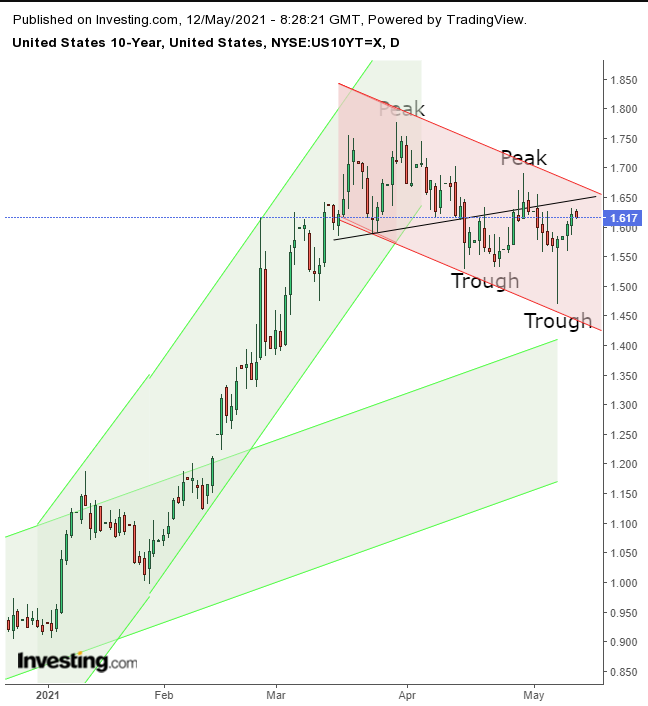
After topping out they have started a falling channel.
Traders' views on inflation remain unpredictable. If today’s CPI shows an increase, they could either sell the dollar on its lower buying power, or buy it on expectations of a rate hike.
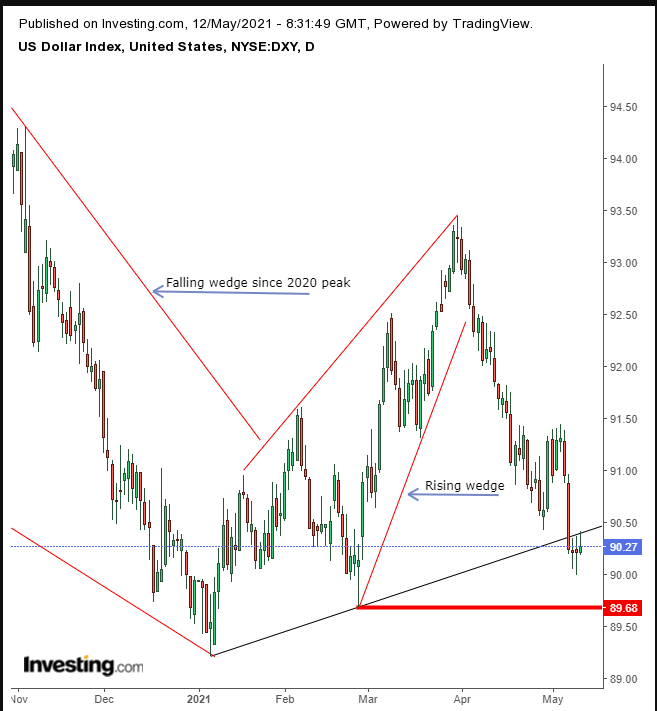
The USD deeply trimmed an advance after finding resistance by the broken uptrend line since the Jan. 6 bottom. We’ll keep holding out for a potential rebound, until that bottom is broken, in which case, it will likely spark a freefall, which can be as steep as to the 2014 lows.
Gold was down for the second day, beneath the top of its falling channel.
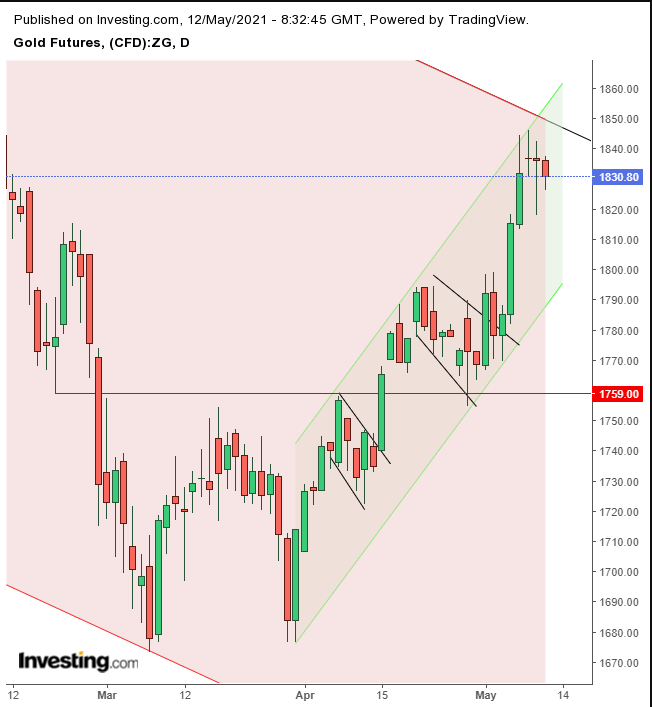
Should CPI reinforce the inflation narrative, gold could break out of its bearish trajectory.
Bitcoin's advance fizzled.
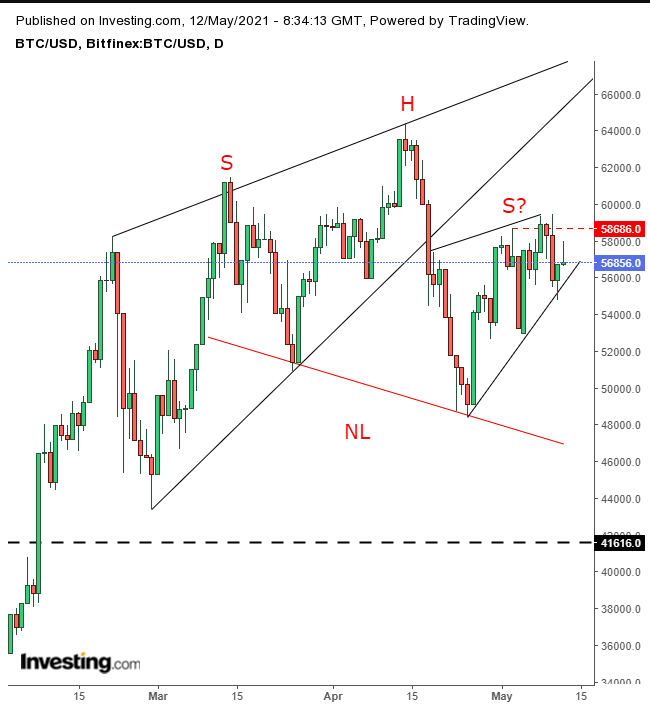
The cryptocurrency may be set to complete a second consecutive bearish wedge and the making of the right shoulder of a H&S top, whose downside target points at the low $30,000 levels.
Oil was stable above $65 per barrel amid dollar weakness and the return of the reflation trade. The biggest US pipeline remains closed in the wake of a cyberattack last week which is leading to acute fuel shortages in some parts of the nation.
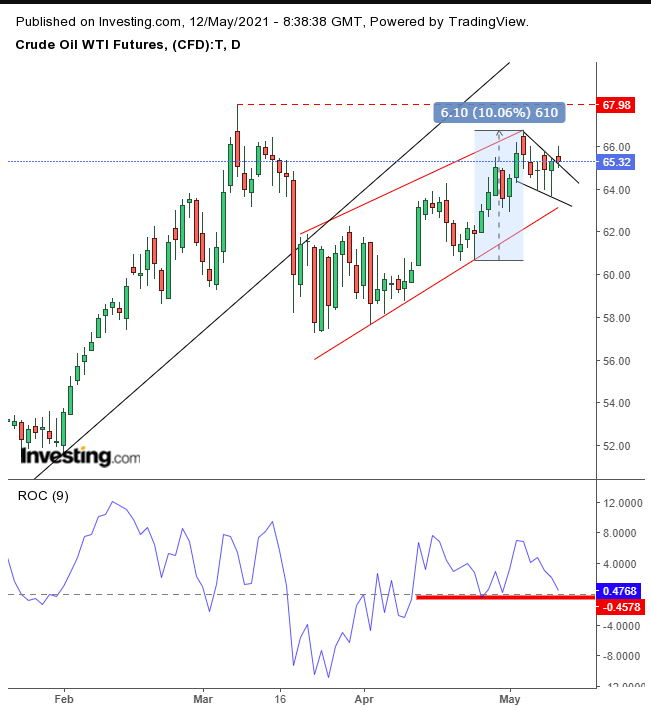
The price of oil may have completed a falling flag, bullish after the preceding 10% advance in just 9 sessions. We see the flag as a clear illustration that early bulls are taking the opportunity to cash out and new bulls are coming in as they take on the Mar. 8 peak. However, keep an eye on the sensitive ROC which gauges momentum. It could be forming a double top. For confirmation, wait for a decisive upside breakout of the flag.
